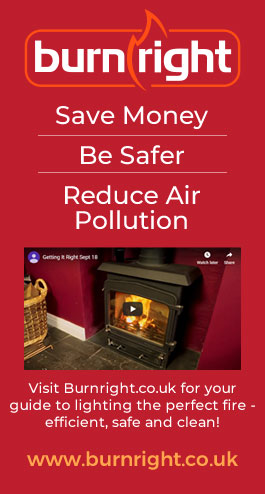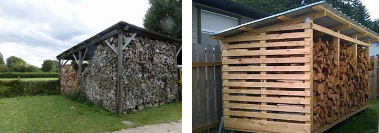CAN I BURN PINE / CONIFER / WILLOW / POPLAR / SOFTWOOD ON MY WOODBURNER?
Yes, is the simple answer, providing the species is dry. You may have been informed that these types of wood cause “tar” or “sap” problems in chimneys, but it is not strictly true.
However, like all wood, they need to be burned at a high enough temperature, and that really is the important bit.
THE SCIENCE BEHIND IT
Most of what is burning when you use logs are “volatile hydrocarbons”. These take the form of tars, creosote, and resins etc. They constitute about 70 – 80% of the available heat energy and are an excellent fuel. When we see flames coming from wood, it is the volatile gasses that are burning.
Most of the rest of the available energy is fixed carbon (charcoal) at around 15 – 18%. When we see wood and embers glowing, it is the fixed carbon that is burning. If the stove is not hot enough it is the volatile tars etc. that can cause a problem.
These volatile hydrocarbon compounds must first be turned in to a gas (vaporised) before they can burn. If the fire is not hot enough these volatile vapours are still given off but are not completely burned in the appliance and they escape to the chimney. If the chimney is cool enough, some of these vapours will condense and solidify on to the inside of the chimney in the same way that water vapour condenses on to a cool bathroom mirror. In a cool chimney they can immediately solidify to form the tarry deposits or creosote glaze which is a problem.
Remember, smoke is simply unburned fuel. This is a serious air pollutant. Much of the available fuel which could have been turned into heat has also been lost. Incomplete or low temperature burning of wood is bad for your chimney, can cause chimney fires and is bad for air quality.
Softer woods are less dense than hardwoods, so you will need to use around 25% more softwood to get the same heat output as hardwood. A kilo of softwood will give about the same heat energy as a kilo of hardwood but because it is less dense it will take up a bit more space in your store. These woods are usually not deemed suitable for open fires as they tend to spit and spark.
It is important to use dry wood. It should only contain 20% moisture or less. Logs should not be too large – around 5 inches wide (125mm) will give the best result.
If you try to use large logs to make the fire last longer, it will generally result in a lower burning temperature, more wasted fuel, and more pollution.
If you are buying logs for immediate use, then tell your supplier you want to use them straight away and you want logs with a 20% moisture content or less. Do not settle for less. Alternatively, look out for the Ready to Burnlogo for reassurance that the logs are dry and sustainably sourced.
NEVER BURN OR ATTEMPT TO BURN WET WOOD
STORING / DRYING YOUR WOOD
If you intend buying logs in quantities above 2 cubic metres, these may likely require storing to allow the wood to dry out properly in readiness for the burning season. A good-sized log store is imperative.
- Stack logs so the air can get at them. If you cut and split them yourself try to do this when the wood is fresh cut as it is much easier on you and your tools. Once split, you have greatly increased the surface area of each piece and it will dry much faster.
- Logs need to be stacked and stored correctly, not heaped in a pile. A well-ventilated log store with open sides and a covered roof is the best option. This should also be on bearers off the ground, and positioned in a sunny, windy location.
- You should be able to achieve a moisture content of 20% or less in around 6 to 12 months if your logs are the right size and stored correctly.
- A Moisture Meter is a very useful tool. Aim for 20% moisture or less. To test the moisture content of any log, split it first and then test the split surface.
OVERNIGHT BURNING IS A BAD IDEA
Never try to “slumber” your stove for long periods / overnight with the air controls closed off too much. Loading up the average stove to slumber for a long period can easily produce more than a kilo of tiny damaging particles which then pass out the top of your chimney and into the air we all breathe.
HOW TO CHECK IF YOU’RE USING THE CONTROLS EFFECTIVELY
Symptoms of extremely poor burning habits include:
- Blackened glass
- Constant smoke from the chimney – the chimney will smoke when first lit and perhaps when refuelling but otherwise there should be no smoke – smoke is simply unburned fuel, loaded with damaging particles
- Unburned wood or charcoal left after the stove goes out
If you would like to discuss your appliance fuel burning requirements or anything to do with your chimney, please do not hesitate to get in touch.
Howard’s (Tarleton) carry full liability insurance and in addition to being Master Chimney Sweep members of the Guild of Master Chimney Sweeps, we are also HETAS registered. We are proud to have been doing what we do for almost 60 years, ensuring the safety of everyone concerned.
We are also a proud member of the Safe Trader Scheme and have received fantastic Testimonials from our customers over the years.
Tel: 01772 812714 / 07762 309526 or Click here to contact us

